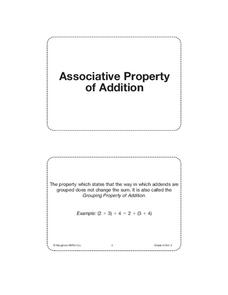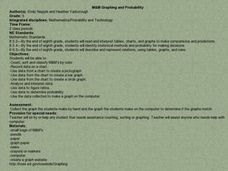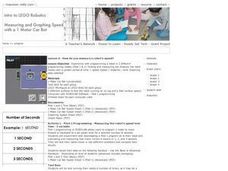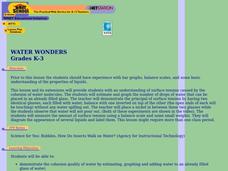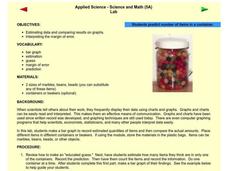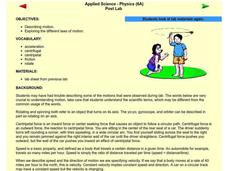Houghton Mifflin Harcourt
Unit 2 Math Vocabulary Cards (Grade 3)
A set of third grade math vocabulary cards include topics that range from addition properties to terms like estimate and fact family. Each sheet has two cards on it. The top half is the word printed in bold text,...
Agriculture in the Classroom
Pumpkins... Not Just For Halloween
Celebrate fall with four pumpkin themed hands-on activities! After learning about pumpkins, scholars complete two activity sheets that reinforce estimation and word problems. They then plant pumpkin seeds and bake a pie in...
EngageNY
Sampling Variability in the Sample Proportion (part 2)
Increase your sample and increase your accuracy! Scholars complete an activity that compares sample size to variability in results. Learners realize that the greater the sample size, the smaller the range in the distribution of sample...
EngageNY
The Difference Between Theoretical Probabilities and Estimated Probabilities
Flip a coin to determine whether the probability of heads is one-half. Pupils use simulated data to find the experimental probability of flipping a coin. Participants compare the long run relative frequency with the known theoretical...
EngageNY
Sampling Variability
Work it out — find the average time clients spend at a gym. Pupils use a table of random digits to collect a sample of times fitness buffs are working out. The scholars use their random sample to calculate an estimate of the mean of the...
Curated OER
Operations with Fractions and Decimals
Complete a lesson that introduces and explores operations with fractions and decimals. Pupils estimate the reasonableness of a decimal computation. Then discuss what operation is needed to find an answer. Handouts, web sources, and other...
Curated OER
Estimation & Central Tendency
Eighth graders view pictures that show many objects, estimate amount that they think they saw, and take class data from estimation to find the mean, median, mode, and range for the class.
Curated OER
Measurement Masterpiece
Here is a good, cross-curricular measurement and estimation lesson. Learners practice measuring paper strips to create an art project. This is a great way to introduce the ruler, and how it used, to your students.
Intel
Metric Madness
Scholars learn about the metric system and produce a presentation on how to convert within the metric system. They then develop a brochure in support of legislation requiring the use of the metric system.
Curated OER
Water Wonders
Students measure the amount of surface tension using a balance scale after a classroom demonstration students diagram the appearance of several liquids and label them.
Curated OER
Ready for Roots
Fourth graders sort seeds and predict what conditions are needed for them to germinate. They keep the seeds moist, observe and measure their growth and graph the results. As the seeds start to grow students compare and contrast the each...
Curated OER
Apples Aplenty
Students identify a variety of apples. In this agriculture lesson, students examine various types of apples and sort them according to attributes. Students describe the apple and create a word web. As an extension activity, students...
Curated OER
Scavenger Hunt for Lengths
Young scholars practice measurement using real world objects. In this scavenger hunt for lengths lesson, students collaborate to measure with rulers, yardsticks, trundle wheels, and tape measures. Young scholars must estimate the...
Curated OER
M&M Graphing and Probability
Students sort, classify, and graph M & M's. They create pictographs and bar graphs with the colors and numbers in each bag of M & M's. They calculate the ratio and probability based on class results.
Curated OER
Percents: What's the Use?
Students explore percentages in real world situations. In this percents instructional activity, students determine the final sales price after discounts. Students interview community members and determine how percentages are used in the...
Curated OER
Percents: What's the Use
Students research percentages in real world situations. In this percents lesson plan, students demonstrate their ability to apply percents to everyday situations. Students communicate mathematically by conducting interviews about...
Curated OER
Introduction to Lego Robotics
Students utilize computer programs to operate a simple robot. In this technology instructional activity, students create robots using Lego pieces and simple motors to move them. Students measure the speed of the robots by...
Curated OER
Sports Participation
Students research statistics about sports participation in references such as the Statistical Abstract of the United States. They make and analyze a list of the 10 sports that the highest number of Americans participated in on an amateur...
Curated OER
Internet Measurement
Students become familiar with how to get information from the Internet. In this math and technology lesson plan, students measure objects on a measurement sheet found on a web site. They practice using a standard unit of measurement...
Curated OER
Water Wonders
Students experiment with the cohesion of water molecules. In this surface tension lesson, students estimate how many drops of water a full glass can take before overflowing. They watch a video that explains water molecules.
Curated OER
How Big is a Breath?
Students demonstrate how to use math skills to measure their lung capacity. In this human biology lesson, students use a clear plastic container, measuring cup and rubber balloons to demonstrate how the lungs work. Students estimate the...
Curated OER
Applied Science - Science and Math Lab
Students make a prediction. In this applied science lesson, students guess the number of items in a jar. Students create a bar graph to show the predictions and the actual amounts.
Curated OER
Laws of Motion
Students explore centrifugal and centripetal force. In this motion lesson, students expand on their knowledge of motion to study velocity, acceleration, and friction. Students examine multiple objects to demonstrate the laws of motion.
Curated OER
Bouncing off the Wall
Students watch a video clips before problem solving the use of angles in real world situations. They problem solve using spatial reasoning while connecting math to a sports activity that investigates the path of a bouncing ball.


